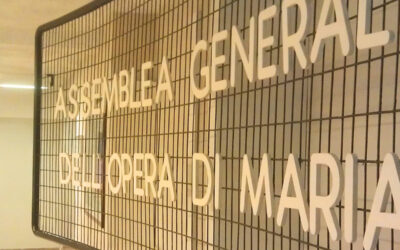In 1968 a race towards heaven by a young girl who found the secret of happiness. Her cause for beatification is currently underway.  Sixteen years old and always on the move. At breakneck speed. Her destination: heaven. Maria Orsola Bussone (October 2, 1954-July 10, 1970) came from Piedmonte, Italy. She loved the pop music of the 1960’s and was interested in student protests. She played guitar and was taking voice lessons. A teenager like all the others, she was in love with nature, sport and music. She jotted down some of her thoughts in a diary, had many friends and wrote letters to the closest ones. She was the simple daughter of an old world that seemed on the verge of being overthrown by the winds of modernism. But her apparently serene life as the child of a tiny village in the Alps of Piedmonte, was hiding an extraordinary soul. A clear and genuine faith. With the support of their priest, and spirituality that gave her a head start, together with other friends, she brought to fruition the guidlines of the Second Vatican Council. Mariolina went into fourth gear and, in a short time, went through all the stages. In 1968 she was invited by the priest don Vincenzo Chiarle to take part in the first Gen congress, the new generation of the Focolare Movement. There Chiara Lubich presented to the youths of the 60’s another revolutionary model: that of a just man, who allowed himself to be immolated for the liberation of others. He also had his program: “That all be one”. Maria Orsola was fascinated, and this became the light of her life. When she was sixteen years old, her young life came to an abrupt end. But she left a stream of light behind her. She once revealed that she would give up her life, if that would help young people to discover God’s beauty. “And God took her at her word”, said John Paul II, speaking to thousands of her fellow citizens in Turin in 1988: “She accepted to transform her life into a gift, not a selfish possession” . “Hooray for life” was her motto.
Sixteen years old and always on the move. At breakneck speed. Her destination: heaven. Maria Orsola Bussone (October 2, 1954-July 10, 1970) came from Piedmonte, Italy. She loved the pop music of the 1960’s and was interested in student protests. She played guitar and was taking voice lessons. A teenager like all the others, she was in love with nature, sport and music. She jotted down some of her thoughts in a diary, had many friends and wrote letters to the closest ones. She was the simple daughter of an old world that seemed on the verge of being overthrown by the winds of modernism. But her apparently serene life as the child of a tiny village in the Alps of Piedmonte, was hiding an extraordinary soul. A clear and genuine faith. With the support of their priest, and spirituality that gave her a head start, together with other friends, she brought to fruition the guidlines of the Second Vatican Council. Mariolina went into fourth gear and, in a short time, went through all the stages. In 1968 she was invited by the priest don Vincenzo Chiarle to take part in the first Gen congress, the new generation of the Focolare Movement. There Chiara Lubich presented to the youths of the 60’s another revolutionary model: that of a just man, who allowed himself to be immolated for the liberation of others. He also had his program: “That all be one”. Maria Orsola was fascinated, and this became the light of her life. When she was sixteen years old, her young life came to an abrupt end. But she left a stream of light behind her. She once revealed that she would give up her life, if that would help young people to discover God’s beauty. “And God took her at her word”, said John Paul II, speaking to thousands of her fellow citizens in Turin in 1988: “She accepted to transform her life into a gift, not a selfish possession” . “Hooray for life” was her motto.
Be careful not to focus too much on yourself!
Be careful not to focus too much on yourself!





0 Comments